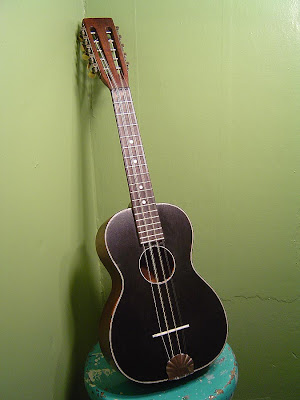c.1920s Unmarked Srpuce & Koa Tiple

This tiple just sold last evening, to a lucky buyer. This is quite a nice one. It was made c.1920s (or early 1930s?) by probably Regal or Lyon & Healy. It features koa back, sides, and neck, with nice figuring throughout. The top is spruce and I've refinished the fretboard and top, (and dyed and distressed the top to look like a vintage blacktop instrument) as they were covered in a glazy overspray of newer finish... not to mention someone had "installed" a bridge in the completely wrong location (see photos lower down for 'before' pics).

This thing looks the business, definitely. Almost jazz-age cool. I've cut a new bridge from bone and installed a mandolin-style tailpiece from the same vintage. This setup gives the instrument terrific sustain and oomph with a nice clarity that is sometimes lacking in the pin/pull style bridges usual (and since removed) from this instrument.

Detail.

Nice slotted headstock with ebony nut, original tuners, and ivoroid buttons.

MOP dots. This fretboard was a mess beforehand with a glazed ugly finish on it. I've stripped it, recolored it, and conditioned it... with the result being a nice, original-feeling, cozy fretboard.

Note the tortoise binding all over with multi-ply purfling to boot.

Sides. Check out how that tortoise catches the light. Very nice.

Back.

Back detail.

Figure in the koa.

Headstock back w/ivoroid buttons.

Other side.

Detail of the wonderful figure in the side koa.

Tailpiece and ivoroid end pin.

As-found condition in this photo... note the improper bridge position and overspray all over the top and fretboard. The bridge was both glued AND bolted in the wrong place...!

...with this result.
And in case anyone needs clarification: a North American tiple (tee-play) is a 10-metal strung instrument of roughly tenor uke size and tuning (gCEA or aDF#B) with strings arranged in octaves in a 2-3-3-2 pattern. There are also South American (specifically Colombian) tiples that are bigger and tuned lower to DGBE with 10 or 12 strings.

Comments
I like your blog- you get to work on some really nice instruments! I was wondering if you might be able to answer a question for me: I just picked up a mid 30's Slingerland Archtop tenor (81 series?). the neck is a bit loose (it wobbles about 1/8" side to side) and I was wondering if you have any advice on securing it. I was thinking that a trim head screw through the 15th fret would do the trick along with some glue between the fingerboard and the body. What do you think?
Thanks,
Jon
I love your site. You do amazing restorations.
J Bartel: Thanks for the kudos! I can answer that for you easily: if you can't nudge/wiggle glue down under the edge of the heel joint into the joint, remove the heel cap with a disassembly knife, and drill a tiny pilot hole into the neck pocket and then syringe/squeeze glue with a funnel into the hole so it goes down into the pocket.
Then arrange pressure with weights, clamps, anything you can (I often turn the instrument over and weight down the top at the heel to "press down" the neck into position while it's raised at the headstock with something) -- to get it to set up.
After that the neck shouldn't wobble because it's really in your heel joint that it's loose. Often archtop necks can be completely unglued and yet still have a good enough joint to hold string tension.
Keith: With black sumi india ink and gouache, for black, but generally stains for others. Keep in mind when using india ink that you must use a non-water-based finish to seal it all up.